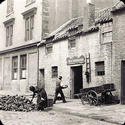 In 1914 Glasgow's huge industrial base and growing population consumed vast quantities of fuel and the city's position within the Lanarkshire coalfield, then the dominant coal-producing county in Scotland, was crucial. Although most mining activity was concentrated to the south and east of the city in the Hamilton, Motherwell, Monklands and Kilsyth districts, at least thirty mines operated either within or on the edge of Glasgow. Central heating and electric light had yet to become a feature of domestic life so most homes had coal fires and oil or gas lamps. Almost all electricity was produced by coal-fired generating stations, and all gas from coal in the retorts of large town-gas works. Other industries such as chemicals, glass, and iron and steel were also voracious consumers of coal, as were the railways, which relied upon steam locomotives. Glasgow's mines yielded mostly house and manufacturing coal, but significant quantities of gas and coking coals and ironstone were also produced, with fireclay often a useful by-product.
In 1914 Glasgow's huge industrial base and growing population consumed vast quantities of fuel and the city's position within the Lanarkshire coalfield, then the dominant coal-producing county in Scotland, was crucial. Although most mining activity was concentrated to the south and east of the city in the Hamilton, Motherwell, Monklands and Kilsyth districts, at least thirty mines operated either within or on the edge of Glasgow. Central heating and electric light had yet to become a feature of domestic life so most homes had coal fires and oil or gas lamps. Almost all electricity was produced by coal-fired generating stations, and all gas from coal in the retorts of large town-gas works. Other industries such as chemicals, glass, and iron and steel were also voracious consumers of coal, as were the railways, which relied upon steam locomotives. Glasgow's mines yielded mostly house and manufacturing coal, but significant quantities of gas and coking coals and ironstone were also produced, with fireclay often a useful by-product.
 The most important centres of mining were in the east of the city around Tollcross, Shettleston and Mount Vernon, and the largest collieries, employing between 500 and 1,000 miners each, included Govan, Kenmuirhill, Viewpark and Bargeddie. There were also large mines immediately to the south in Rutherglen, Uddingston, Cambuslang, Bothwell and Giffnock, notable examples being Farme, Blantyreferme and Thornliebank.
The most important centres of mining were in the east of the city around Tollcross, Shettleston and Mount Vernon, and the largest collieries, employing between 500 and 1,000 miners each, included Govan, Kenmuirhill, Viewpark and Bargeddie. There were also large mines immediately to the south in Rutherglen, Uddingston, Cambuslang, Bothwell and Giffnock, notable examples being Farme, Blantyreferme and Thornliebank.
 With the onset of the Depression after the First World War coal mining stagnated and by 1934 the number of mines in and around Glasgow had fallen by two thirds. Garscube Colliery in Maryhill had however been re-opened and, an important new development on the eastern edge of the city at Stepps, Cardowan Colliery, had commenced production of coking coal for Messrs Nimmo & Dunlop in 1929. Nevertheless the overall decline continued and by nationalisation in 1947 only Garscube, Cardowan, Blantyreferme, Bardykes, and Coatspark had survived. The National Coal Board developed a temporary drift mine at Greenlees near Cambuslang in 1948, but this worked for only ten years. Thereafter, no new mines were sunk in the city.
With the onset of the Depression after the First World War coal mining stagnated and by 1934 the number of mines in and around Glasgow had fallen by two thirds. Garscube Colliery in Maryhill had however been re-opened and, an important new development on the eastern edge of the city at Stepps, Cardowan Colliery, had commenced production of coking coal for Messrs Nimmo & Dunlop in 1929. Nevertheless the overall decline continued and by nationalisation in 1947 only Garscube, Cardowan, Blantyreferme, Bardykes, and Coatspark had survived. The National Coal Board developed a temporary drift mine at Greenlees near Cambuslang in 1948, but this worked for only ten years. Thereafter, no new mines were sunk in the city.